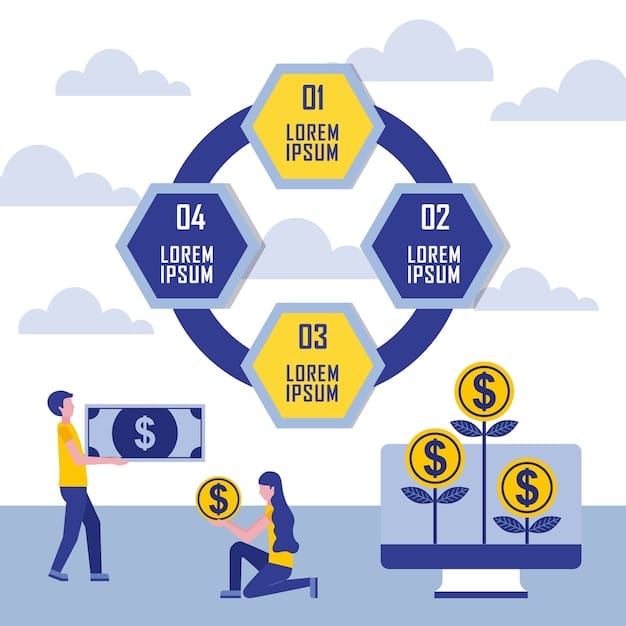Understanding SAFE Notes: Your Guide to Startup Funding in the US

Understanding SAFE Notes: A Comprehensive Guide for US Startups Seeking Early-Stage Funding explains how Simple Agreements for Future Equity (SAFE) offer a streamlined approach to securing investments. This guide explores SAFE notes, their advantages, disadvantages, and crucial considerations for startups in the US.
Navigating the world of early-stage startup funding can feel like traversing a labyrinth. Among the various options available, Simple Agreements for Future Equity, or SAFE notes, have emerged as a popular choice for US startups. Understanding SAFE Notes: A Comprehensive Guide for US Startups Seeking Early-Stage Funding is crucial for making informed decisions.
This guide breaks down the complexities of SAFE notes, examines their benefits and drawbacks, and offers insights to help you determine if a SAFE note is the right fit for your funding strategy. Let’s dive in!
Understanding SAFE Notes: A Concise Overview for US Startups
SAFE notes, or Simple Agreements for Future Equity, represent a simplified method for startups to raise capital. Essentially, a SAFE note is an agreement between a startup and an investor. Instead of an immediate equity stake, the investor receives the right to purchase equity in the company at a later date, typically during a priced equity round. This model avoids the complexities of valuing the company early on.
Understanding SAFE Notes: A Comprehensive Guide for US Startups Seeking Early-Stage Funding requires delving into the specific terms and conditions outlined in the SAFE agreement, which we’ll explore in the following sections.
Key Components of a SAFE Note
A SAFE note is composed of several key components that define its terms and conditions. Understanding these components is vital for both startups and investors.
- Discount Rate: The discount rate gives the SAFE holder the right to purchase shares at a discounted price compared to other investors in the future equity round.
- Valuation Cap: The valuation cap sets a maximum valuation at which the SAFE converts into equity, protecting the investor if the company’s valuation soars.
- Liquidity Preference: This outlines the investor’s rights in the event of a company sale or liquidation.
- Pro-Rata Rights: These rights allow the investor to maintain their ownership percentage in future equity rounds.
Selecting the right terms for a SAFE note requires careful consideration of the startup’s financial projections, market conditions, and long-term growth strategy. Negotiating fair terms ensures both the startup and the investor are aligned for success.
In conclusion, understanding the fundamental aspects of SAFE notes is key to navigating early-stage funding successfully. By grasping each component and its implications, startups can make informed decisions and secure the capital they need to grow.
The Advantages of Using SAFE Notes for US-Based Startups
For startups based in the US, SAFE notes offer a range of advantages that can make them a compelling choice for early-stage funding. These advantages include simplicity, speed, and flexibility in structuring deals.
One of the primary benefits of Understanding SAFE Notes: A Comprehensive Guide for US Startups Seeking Early-Stage Funding is recognizing how they streamline the fundraising process compared to traditional equity rounds.
Simplicity and Speed
SAFE notes are designed to be simpler and faster to execute than traditional equity rounds. This is primarily because they avoid the need for immediate valuation, which can be a time-consuming and expensive process.
The streamlined documentation and reduced legal costs associated with SAFE notes make them an attractive option for startups with limited resources. The ability to quickly close funding rounds allows startups to focus on their core business activities.

Flexibility in Structuring Deals
SAFE notes provide flexibility in structuring deals, allowing startups and investors to negotiate terms that align with their specific needs and goals. This flexibility can be particularly beneficial for startups in rapidly evolving industries.
SAFE notes can be customized with different discount rates, valuation caps, and other terms to attract investors while maintaining control over the company’s equity. This adaptability makes SAFE notes a versatile tool for early-stage funding.
In summary, the advantages of using SAFE notes for US-based startups are numerous. Their simplicity, speed, and flexibility make them an attractive option for raising early-stage capital and driving growth. By understanding these benefits, startups can leverage SAFE notes to their advantage.
Potential Drawbacks of SAFE Notes for US Startups Seeking Funding
While SAFE notes offer several benefits, US startups should also be aware of the potential drawbacks before deciding to use them for funding. These drawbacks include complexity in cap table management and potential misalignment with investor expectations.
Understanding SAFE Notes: A Comprehensive Guide for US Startups Seeking Early-Stage Funding also involves recognizing situations where SAFE notes might not be the best approach.
Complexity in Cap Table Management
SAFE notes can introduce complexity into a startup’s cap table, particularly if multiple SAFE notes with varying terms are issued. This complexity can make it challenging to manage equity ownership and calculate the impact of future equity rounds.
Careful planning and tracking are essential when managing a cap table with SAFE notes. Startups should use cap table management software and seek legal advice to ensure accurate record-keeping and compliance.
Potential Misalignment with Investor Expectations
SAFE notes can sometimes lead to misalignment between startups and investors if the terms are not clearly understood or if expectations are not properly managed. This can result in disputes or dissatisfaction down the road.
- Clear communication of the terms and conditions
- Setting realistic expectations for both parties
- Seeking legal advice to ensure compliance
These steps are essential for mitigating potential conflicts and fostering a positive relationship between startups and investors.
In conclusion, while SAFE notes offer numerous advantages, it’s important for US startups to carefully consider the potential drawbacks. By understanding these challenges and taking proactive steps to mitigate them, startups can use SAFE notes effectively and avoid potential pitfalls.

Navigating the Legal and Tax Implications of SAFE Notes in the US
US startups must navigate the legal and tax implications of SAFE notes to ensure compliance and avoid potential liabilities. These implications can vary depending on the specific terms of the SAFE note and the jurisdiction in which the startup operates.
As part of Understanding SAFE Notes: A Comprehensive Guide for US Startups Seeking Early-Stage Funding, comprehending these legal and tax aspects is essential.
Legal Compliance
SAFE notes are subject to various legal requirements, including securities laws and regulations. Startups must comply with these requirements to avoid potential legal issues.
Consulting with legal counsel is crucial to ensure compliance with applicable laws and regulations. Properly drafted SAFE agreements and disclosure documents can help mitigate legal risks.
Tax Considerations
SAFE notes can have significant tax implications for both startups and investors. The tax treatment of SAFE notes can vary depending on the specific terms of the agreement and the applicable tax laws.
Startups and investors should seek tax advice from qualified professionals to understand the tax implications of SAFE notes. Proper tax planning can help minimize tax liabilities and maximize financial benefits.
In summary, navigating the legal and tax implications of SAFE notes is essential for US startups. By seeking legal and tax advice, startups can ensure compliance, minimize risks, and maximize the benefits of using SAFE notes for funding.
Strategies for Successful SAFE Note Negotiations in the US Startup Ecosystem
Successful SAFE note negotiations are essential for US startups to secure favorable funding terms while maintaining control over their company’s equity. Effective negotiation strategies can help startups attract investors and achieve their fundraising goals.
Negotiating effectively is a critical aspect of Understanding SAFE Notes: A Comprehensive Guide for US Startups Seeking Early-Stage Funding.
Setting Realistic Expectations
Startups should set realistic expectations for SAFE note terms, including discount rates, valuation caps, and other key provisions. Overly aggressive terms can deter investors, while overly generous terms can dilute equity ownership.
- Researching market benchmarks for SAFE note terms
- Understanding investor preferences and priorities
- Seeking advice from experienced advisors and mentors
These steps can help startups establish realistic expectations and negotiate fair terms.
Building Strong Relationships with Investors
Building strong relationships with investors is crucial for successful SAFE note negotiations. Investors are more likely to offer favorable terms to startups they trust and believe in.
Transparent communication, mutual respect, and a shared vision for the company’s success can foster strong relationships with investors. Building these relationships can position startups for successful negotiations and long-term partnerships.
In conclusion, successful SAFE note negotiations require careful planning, realistic expectations, and strong relationships with investors. By employing effective negotiation strategies, US startups can secure favorable funding terms and drive their growth and success.
| Key Concept | Brief Description |
|---|---|
| 💡 SAFE Note | Agreement for future equity, simplifying early-stage funding. |
| 💸 Discount Rate | Allows SAFE holder to purchase shares at a reduced price. |
| 上限 Valuation Cap | Sets maximum valuation for SAFE conversion into equity. |
| 🤝 Negotiation | Critical for favorable terms and investor relationships. |
Frequently Asked Questions About SAFE Notes
A SAFE note is a Simple Agreement for Future Equity, a contract that grants investors future equity rights in exchange for early-stage funding. Given Understanding SAFE Notes: A Comprehensive Guide for US Startups Seeking Early-Stage Funding , SAFE notes are appealing because they streamline the fundraising process without requiring immediate valuation.
Standard SAFE note terms include a discount rate, valuation cap, liquidity preferences, and pro-rata rights. These terms define the investor’s rights and conditions under which the SAFE note will convert into equity.
Effective negotiation involves setting realistic expectations, deeply examining Understanding SAFE Notes: A Comprehensive Guide for US Startups Seeking Early-Stage Funding‘s best practices, and building strong investor relationships. Startups should clearly communicate their vision and understand investor priorities.
Potential risks include complexity in cap table management and possible misalignment with investor expectations if the terms are not well-understood. Careful planning is crucial to mitigate these risks.
Startups can find SAFE note templates from organizations like Y Combinator, or seek legal advice from attorneys specializing in startup funding. Professional guidance ensures compliance and protects the startup’s interests.
Conclusion
Understanding SAFE Notes: A Comprehensive Guide for US Startups Seeking Early-Stage Funding is essential for navigating the complex landscape of startup finance. By grasping the advantages, potential drawbacks, and legal implications of SAFE notes, US startups can make informed decisions and secure funding to fuel their growth.
Leveraging the knowledge and strategies outlined in this guide can empower startups to negotiate favorable terms, build strong investor relationships, and ultimately achieve their long-term goals, all the while driving innovation and contributing to the vibrant US startup ecosystem.





